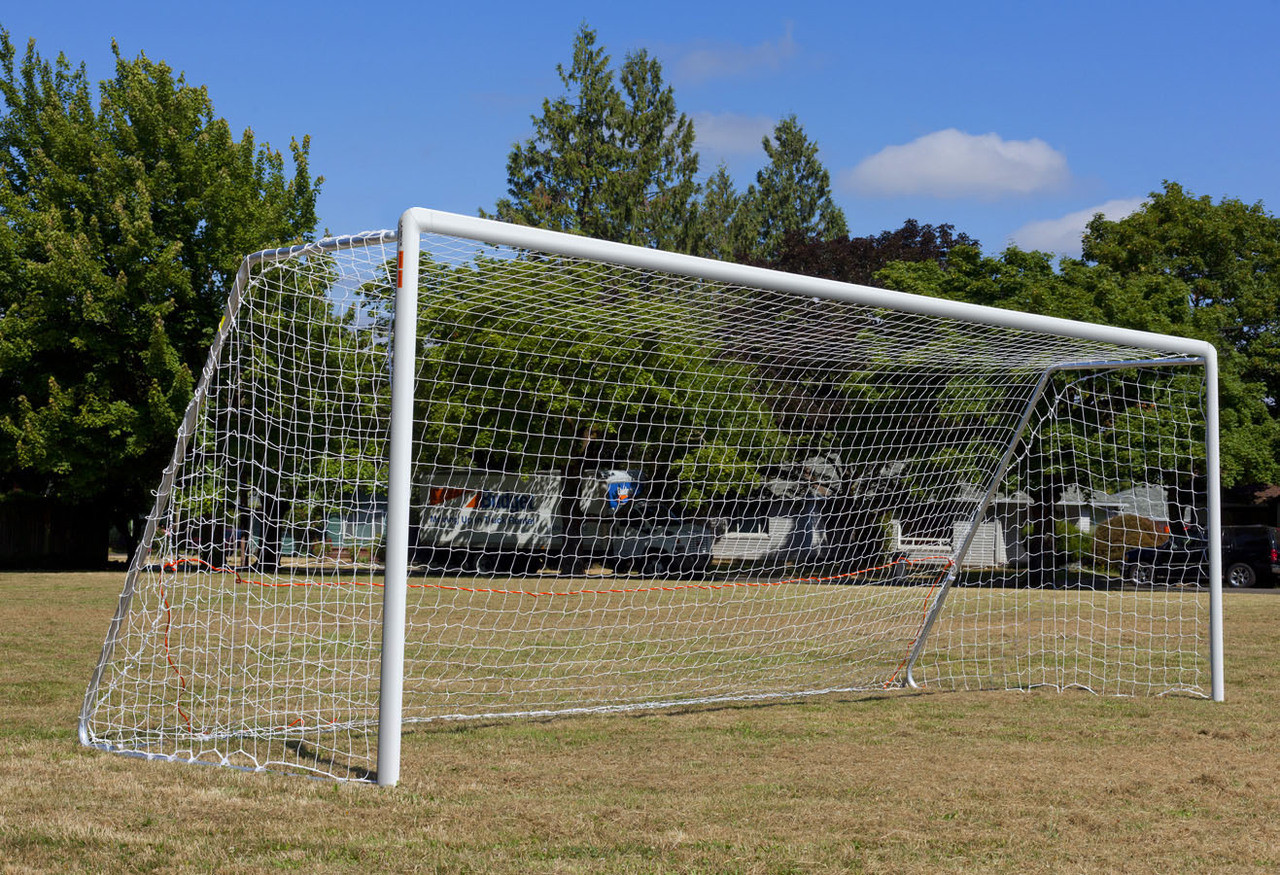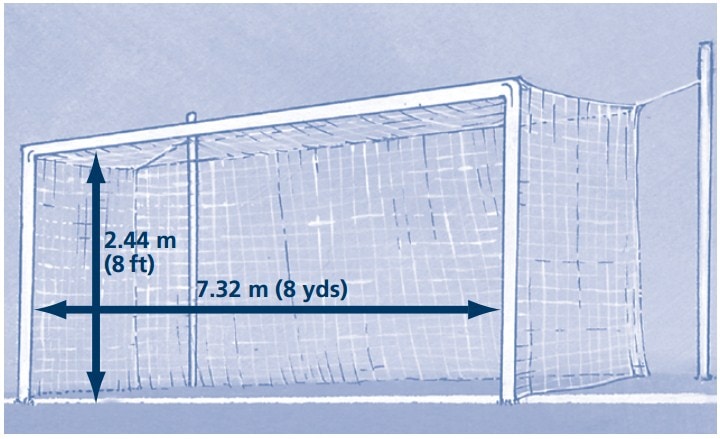What Is The Size Of A Regulation Soccer Goal
A regulation soccer goal is an essential component of any soccer game. The size of a regulation soccer goal is standardized to ensure fairness and consistency in the sport. In this article, we will explore the dimensions of a regulation soccer goal, its importance in the game, and answer some common questions about soccer goals.
The Dimensions of a Regulation Soccer Goal
Regulation soccer goals have specific dimensions that must be adhered to in official competitions. According to the regulations set by the International Football Association Board (IFAB), the dimensions of a regulation soccer goal are as follows:
The width of the goal is 24 feet (7.32 meters), while the height is 8 feet (2.44 meters). The goal posts and crossbar must be made of approved materials, such as wood or metal, and should have a circular or square cross-sectional shape. The goal frame should not pose any danger to the players.
The Importance of Regulation Soccer Goals
Regulation soccer goals play a crucial role in the game for several reasons:

1. Fairness: Having standardized goal dimensions ensures fairness in the game. Both teams have equal opportunities to score and defend, as the dimensions remain consistent across different matches and venues.
2. Skill Development: Playing with regulation goals helps players develop their shooting and goalkeeping skills. The specific dimensions challenge players to aim accurately and improve their technique.
3. Professionalism: Regulation goals are used in professional soccer leagues worldwide. By adhering to the standard dimensions, the game maintains a professional and consistent appearance.
Subheading 1: Variations in Goal Sizes
While the standard dimensions of a regulation soccer goal are widely used, there are variations in goal sizes for different age groups and soccer formats. Here are some common variations:
- Youth Goals: Goals used in youth soccer are often smaller to accommodate the smaller size of the players. The width may be reduced to 18.5 feet (5.64 meters), and the height to 6.5 feet (1.98 meters).
- Indoor Goals: Indoor soccer is typically played in smaller venues, so the goals are smaller as well. The dimensions may vary, but a common size is 6.5 feet (1.98 meters) in height and 12 feet (3.66 meters) in width.
- Futsal Goals: Futsal is a variant of indoor soccer that is played on a hard court with a smaller ball. Futsal goals are even smaller, with dimensions of 6.5 feet (1.98 meters) in height and 9.8 feet (3 meters) in width.
These variations in goal sizes ensure that the game remains suitable and enjoyable for players of different ages and in different playing environments.
Subheading 2: Frequently Asked Questions
1. Are all soccer goals the same size?
No, soccer goals can vary in size depending on the age group, format of the game, and playing environment. However, regulation soccer goals have standardized dimensions that are followed in official competitions.
2. Can a soccer goal be too big or too small?
While it's important to have consistent goal sizes to maintain fairness, goals that are significantly larger or smaller than the standard dimensions can affect the balance of the game. For example, larger goals favor attacking teams, while smaller goals benefit the defense. It's essential to adhere to appropriate dimensions for each age group and soccer format.
3. How are soccer goals secured?
Soccer goals are traditionally secured to the ground using anchors or weights. This ensures that the goal remains stable during the game, even in windy conditions. Safety precautions should be taken to prevent the goal from tipping over and causing injuries.
4. What are the materials used for soccer goals?
Soccer goals are commonly made of metal or high-density polyethylene plastic. Metal goals are more robust and durable, while plastic goals are lightweight and portable, making them suitable for recreational use.
5. Can soccer goals be used for other sports?
Yes, soccer goals can be used for other sports, such as field hockey or lacrosse, with appropriate modifications. Some goal frames are designed to accommodate nets for multiple sports, making them versatile for various recreational activities.
Conclusion
The dimensions of a regulation soccer goal are a fundamental aspect of the game. They ensure fairness, aid skill development, and contribute to the professionalism of soccer. While there are variations in goal sizes for different age groups and formats, the standard dimensions provide a consistent and reliable framework for the sport. By understanding the importance of regulation soccer goals, players, coaches, and fans can appreciate the technical aspects of the game and enjoy the sport to its fullest.
FAQs (Frequently Asked Questions)
- Are all soccer goals the same size?
- Can a soccer goal be too big or too small?
- How are soccer goals secured?
- What are the materials used for soccer goals?
- Can soccer goals be used for other sports?
These frequently asked questions provide insight into common queries related to soccer goals and help clarify any doubts players or enthusiasts may have.
For more information on soccer goals, you can refer to authoritative sources such as soccer associations, sports equipment manufacturers, or consult with trained soccer coaches and referees.
Regulation Soccer Goal Aluminum-Official Size By Stackhouse - Head
 Image Source : headcoachsports.com
Image Source : headcoachsports.com regulation stackhouse
*Discounted Less Than Perfect* Special Coated 21' X 7' Soccer Goal, One
 Image Source : www.g3elite.net
Image Source : www.g3elite.net regulation soccer goal youth
Contoh Gambar Lapangan Sepak Bola Beserta Ukurannya ~ Gambar Lapangan
 Image Source : gambarlapangansepakbolaforus.blogspot.com
Image Source : gambarlapangansepakbolaforus.blogspot.com From Amateur To Pro – How The Size Of A Soccer Goal Impacts The Game
 Image Source : clubleonen.com
Image Source : clubleonen.com Vallerta® 24x8 Ft. Regulation Size Soccer Goal W/ TWO NETS!! (Black) | EBay
soccer regulation goal size ft 24x8 vallerta nets two
Youth Soccer Boot Camp
 Image Source : youthsoccerbootcamp.blogspot.com
Image Source : youthsoccerbootcamp.blogspot.com soccer goal size dimensions regulation build
Soccer Goal Dimensions
 Image Source : www.slideshare.net
Image Source : www.slideshare.net goal soccer dimensions slideshare
Size Of A Regulation Soccer Net | LIVESTRONG.COM
 Image Source : www.livestrong.com
Image Source : www.livestrong.com size
From amateur to pro – how the size of a soccer goal impacts the game. Youth soccer boot camp. *discounted less than perfect* special coated 21' x 7' soccer goal, one. Size of a regulation soccer net. Contoh gambar lapangan sepak bola beserta ukurannya ~ gambar lapangan